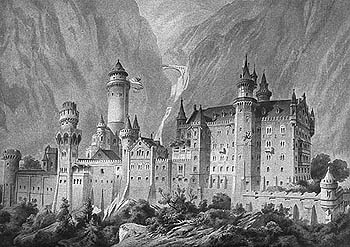![]()
First plans
The first plans were drawn up in 1867, soon after Ludwig's failed engagement. To help himself recover from the ordeal he threw himself totally into designing his new castle. Christian Jank, the scenery designer at the Court Theatre, painted the designs for the castle, which accounts for the dreamy, fairy-tale appearance of the building. These initial designs were then translated into architectural plans by Eduard Riedel.
Christian Jank's first design, 1867. (Note the Marienbrücke in the distance.)
At first, Neuschwanstein was planned to be a small but ornate castle in a high Gothic style, with delicate turrets topped bt high-pointed roofs. Dominating the castle is a huge tower, referred to as the Keep. This plan was obviously too small, and Jank's second design shows a larger and more ornate castle in a German Gothic style. The idea of the Keep appears once more.
Christian Jank's second design, 1868.
As the planning stage advanced, the castle's style changed from Gothic to Romanesque, and it's size grew to be of enormous proportions.
 |
Christian Janks' 1869 design for the new castle - that which was finally adopted.
"A worthy temple . . ."
By 1869 the castle had became a massive temple to Wagner, and Christian Jank's design from 1869 was adopted for the project. The general architectural feel of this design was based in part on the sets for the 1867 production of "Lohengrin" in Munich, these being designed by Angelo II Quaglio - the artist who created most of the frescoes in Hohenschwangau.
Ludwig had ordered that the castle was to have references to Act 2 of "Lohengrin", and both Act 1 and Act 3 of "Tannhäuser".
On May 13, 1868, Ludwig wrote what would become an important letter to Wagner explaining the idea of his new work.
"I propose to rebuild the ancient castle ruins of Vorderhohenschwangau *, near the Pöllat Falls, in the genuine style of the old German knight's castles, and I must tell you how excited I am at the idea of living there in three years time. There will be a number of guest rooms, comfortably and conveniently furnished ans commanding wonderful views over the majestic Sauling, the mountains of the Tyrol, and the distant plain. You will know who the guest is whom I want to invite and entertain there. The spot is one of the loveliest that can be found, inviolable and inaccessible, a worthy temple for the godlike Friend through whom alone can flower the salvation and true blessedness of the world.
"There will be reminiscences of "Tannhäuser" (Minstrel's Hall with a view of the castle beyond) and of "Lohengrin" (castle courtyard, outside passageway and approach to the chapel); this castle will be in every respect more beautiful and more comfortable than the lower-lying Hohenschwangau . . ."
* The castle was referred to as Vorderhohenschwangau ("Further Hohenschwangau") during Ludwig's lifetime. It was renamed Neuschwanstein ("New swan's stone") soon after the King's death.
![]()